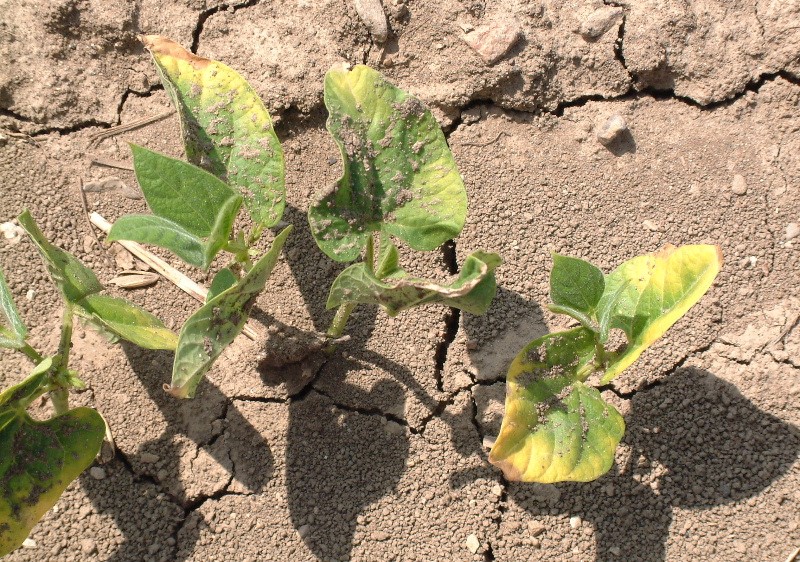Group 15 active ingredients commonly used for weed control in Ontario dry beans include S-metolachlor (Dual II Magnum) and dimethenamid-P (Frontier Max). Occasionally these products cause injury; injury is influenced by herbicide application rate and timing, soil crusting, seeding depth, weather conditions, and market class.
Symptoms
Herbicide is primarily absorbed through the elongating epicotyl/hypocotyl. Plants beyond the seedling stage readily absorb the herbicide thorough the roots and it is translocated throughout the plant. Injury symptoms include marginal chlorosis and necrosis of the cotyledons, unifoliates and first trifoliate leaves. In severe cases the lower leaves will be completely necrotic and fall off. Plant development may be delayed.
Market Classes
Local experience and research have indicated that adzuki beans are most sensitive, black and white beans have intermediate sensitivity, and cranberry and kidney beans are generally more tolerant.

Recommended Use Patterns
The Dual II Magnum label outlines the following:
- Use pre-plant incorporated (PPI) in common bean (Phaseolus vulgaris)
- Use PPI or pre-emergence (PRE) in cranberry beans
- Not registered for use in adzuki bean (Vigna angularis)
- Dry bean varieties may vary in their tolerance to Dual
- Dual II Magnum tank mixes with Pursuit have not been tested on all market classes
- Beans should be seeded at least 4 cm (1.5”) deep or injury may occur
The Frontier Max label outlines the following:
- Use PPI in common bean (Phaseolus vulgaris)
- Do not apply PRE or if beans have emerged
- Not registered for use in adzuki bean (Vigna angularis)
- Market classes vary in tolerance, and Frontier alone or in combination with Pursuit have not been tested on all classes
- Early crop injury may be observed, but should not affect yield
Local experience and research conducted at the University of Guelph have shown that Dual and Frontier are safer when applied preplant incorporated. Applying 5-6 days ahead of planting improves the crop safety.
In a spring strip-till system, producers may consider applying the group 15 products prior to strip-tilling. The planter provides some level of incorporation but tillage provides superior incorporation of the herbicide into the soil reducing the risk of herbicide injury.
Increased Potential for Risk
On-farm examples of injury have typically occurred when products were applied PRE. In addition, cool conditions, heavy rainfall pre or post bean emergence, or rainfall just as the beans are breaking through the soil surface are potentially high risk, for PRE applications and rarely with PPI applications.
When there are other plant stresses at play, such as disease, or plants are otherwise growing slowly there may be more potential for risk of injury by the Group 15 products. Areas of the field with soil compaction may have significantly more injury. Dry beans may also be more likely to exhibit injury when they are metabolizing multiple herbicides from tank mixtures and/or herbicide residues in soil (carry over). Of course, sprayer overlaps may also result in injury.
Course textured soils or soils low in organic matter may be more prone to injury, and lower rates of Group 15 products are recommended on these soils.
Replant Decisions
Depending on the extent of the injury, dry beans may recover from Group 15 carry over injury. Injured plants may recover but may be stunted or delayed. Delayed maturity can be problematic for a timely harvest of high-quality beans. Yield losses of up to 50% with Group 15 tankmixes have been observed.
Ensure the replanted crop will mature in time for harvesting in September. Consider replanting to a less susceptible market class such as cranberry or kidney beans. The replanted beans will be at lower risk of injury because the time between herbicide application and planting is longer and a portion of the herbicide will have degraded, but the level of risk is still dependant on rainfall events and general plant stress. It is not advisable to re-seed patches in an existing field, as this will also cause maturity issues at harvest. In a replant scenario, terminate the first crop with glyphosate prior to replanting.
Dr. Peter Sikkema and his research team are acknowledged for their contributions to this article.













